On my last day in Managua, after the morning walk to the main post-office in the centre of the city, I withdrew to the guest-house and was practically bored. Then at some point I remembered I could do a meditation. But, just as I started, I was interrupted by Patricia who came to pick me up before the agreed time.
I was still nervous and under the negative impression from the day before because of the money spent on taxi which for me at that moment was too much and so I constantly nagged in the privacy of my head (which is very un-Zen-like, but it happens). However, when I saw the broad smile on Patricia’s face, the anger and the nervousness were gone.
So, first we met with Marta and since they both worked on that day, we went to a shopping mall for lunch and had some fast food there. After that we met with Silvia and then all together we went to Patricia’s room (she lived as a lodger, renting a room in a house). There we actually had a very joyful afternoon, full of laughter and joking.
Since I had already established a contact with Patricia from Belgrade, I brought with me a few CDs with music that I considered was representative and constituted some kind of a snapshot of the popular music in Serbia. This is always a very personal choice and this time I chose Goran Bregovic, Sanja Ilic and Balkanika, Jovan Maljokovic and Ceca (By the way, although quite controversial in many aspects, Ceca is more popular than the other three combined. I normally don’t listen to her songs, but I had thought she was representative enough to deserve to be included in my choice.) I had given those CDs to Patricia the previous day and now she told me that she had listened to some of them while she was at work and her favourite was a song by Ceca. So, if Ceca made some big music deal in Nicaragua in the meantime, I think it would be quite fair that I get a percentage of it.
In addition to joking and laughing intensively this afternoon, we also listened to some popular Nicaraguan songs and as I had relaxed quite well in the meantime I even started to recognise the lyrics of some of the songs that we heard a few times.
After a while came Roberto, a friend of Patricia and so we went together to a restaurant/bar/disco where we were also joined by Marta’s son. The hanging together and the laughter could now continue with some beer.
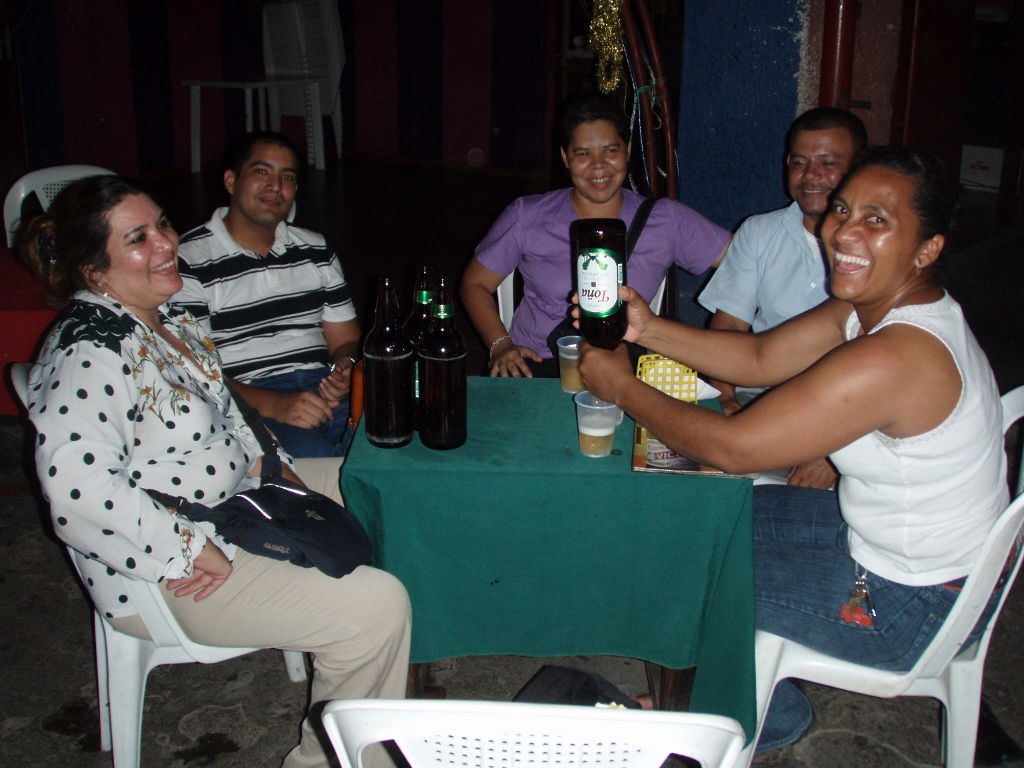 Friends from Managua
Friends from Managua
At some point we heard a song about which we had joked earlier on and now I saw this as an invitation to myself to get up and start dancing. And it was fun, while I enjoyed it all. First Marta filmed the few of us who were dancing and later I filmed Patricia and Roberto.
At some point, they all saw me off for I had to go to bed very early, since again I had to get up before 4 am. And so I did. I got up on time, put on my clothes, took my things and got out in the street where it was still dark. Although there was nobody in the street but me, I took the advice I had heard before and walked in the middle of the street, but there were no problems, especially since the terminal was some hundred metres away from the guest-house at which I stayed. I was ready to start with my return from Managua to Cancun, Mexico, where a couple of weeks later I had a return flight back to Europe.
Here is a map of Nicaragua as a reminder of the roads I took during my brief stay in this country.
When I entered the coach, in the seat for which I had a reservation I saw a young man for whom, judging by his accent, I concluded that he was from Europe. I asked him to move because every time when I was buying tickets for coaches I always asked for a window seat and so since I had gotten it, there was no real reason not to sit there. So, I settled comfortably in my seat and started to nap again, although I did take photos through the window from time to time. That young man who was sitting next to me also wanted to take photos, so when he was doing that I tried to press against my seat as much as possible in order not to be in his way.
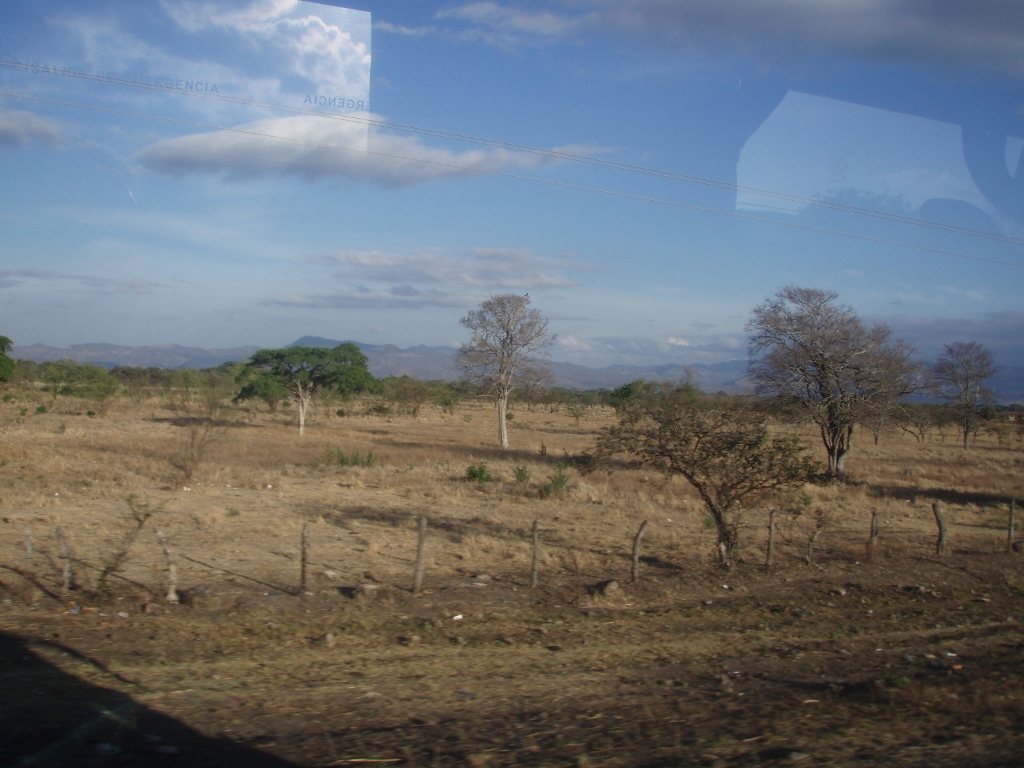 Landscapes northwest of Managua
Landscapes northwest of Managua
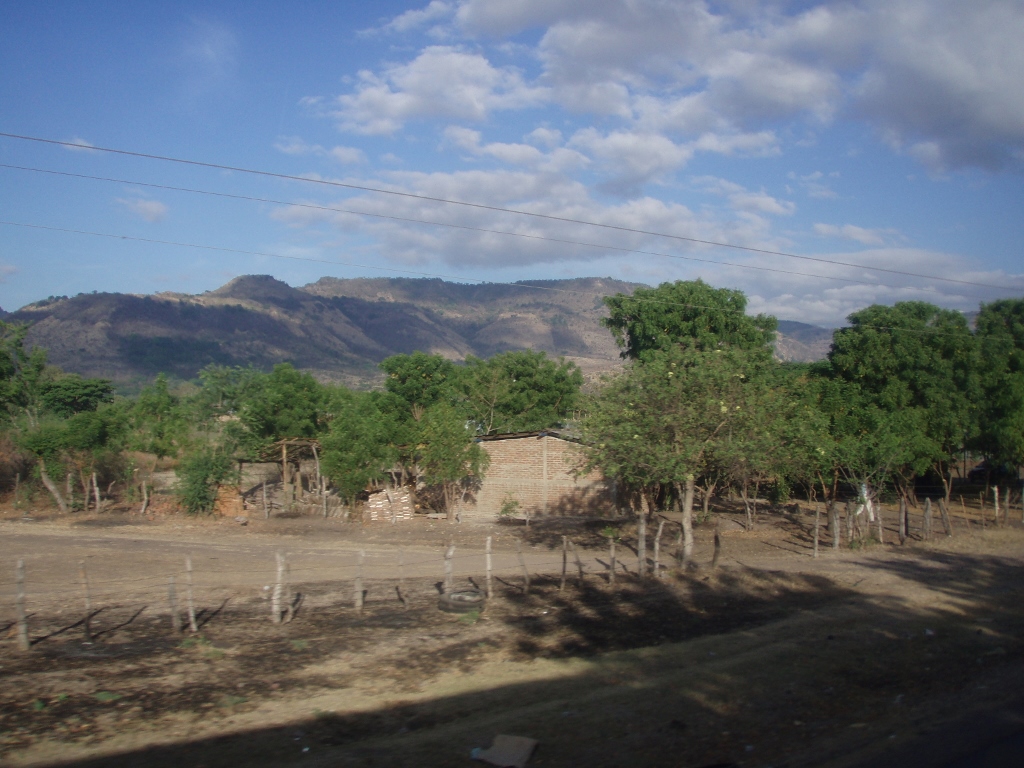 Landscapes northwest of Managua
Landscapes northwest of Managua
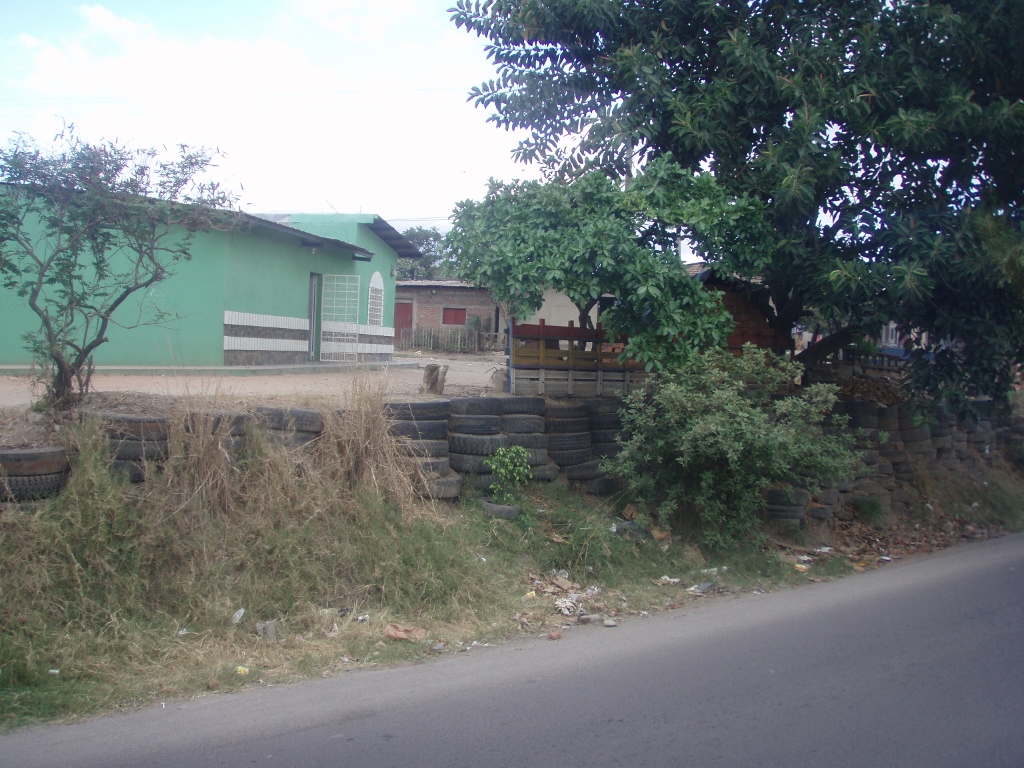 Interesting use of old tires
Interesting use of old tires
There are around 170 km from Managua to the border with Honduras, which is around three hours by coach, and when we got to the border, we had to get out of the coach and while we were waiting there I chatted a little with a gentleman from Nicaragua who was sitting in the row in front of me on the coach. He asked me about my journey and as it turned out he was a forestry engineer I told him, among other things, how delighted I was with the trees in Central America. While we were standing there, I saw by chance the passport of the young man I was sitting next to. Yes, he was from Europe.
After short formalities at the border, we entered Honduras and continued in the direction of the capital, Tegucigalpa. This young man who was sitting next to me often took photos, which I did not mind in the least, but he was starting more and more to lean heavily on me when doing so. I’m sure it was no desire of his to “get closer” to me, but only his desire to get his camera closer to the window, but at some point he really started to overdo it. I asked him not to do that anymore. He said he wouldn’t and then he continued doing the same thing. The situation started to feel a little tense. Then I asked him again to stick to his seat and not to move onto mine, but he simply went on in the same way. After several of such moves of his, I pulled the curtain on the coach’s window and this man went berserk. He jumped over me and started to remove the curtain, but when doing so with one of his hands he passed so close to my face that he almost hit me. It was clear to me that it was not his real intention to hit me, but now I went berserk. I started yelling at him and said that he should not even dream of touching me since I would immediately call the conductor to remove him from the coach. I also told him that he should be ashamed. He came from one VERY strict and well organised western European country (it does not matter which one, since I know many people from there who are quite normal and polite), so I told him I was sure that in his country he behaved like a small frightened mouse and then he went abroad and behaved abominably and in the way he would not even dream of back in his country. I also told him that I had spent months (meaning in total, not only during this journey) travelling across Latin America and NEVER EVER had I had a single awkward situation until that moment. Shame on him!
Needless to say, he fired back telling me I was crazy and something must be wrong with me for I travelled alone (I’m not disputing this, but I would mention for the record that he also travelled alone) and so I concluded it was high time for me to get my inner “damsel in distress” involved. So, I tapped on the shoulder the young man sitting directly in front of me asking him if he would not mind switching seats with me “since I had certain unpleasantries with the man I was sitting next to” (as if he did not know – the whole coach knew, for I yelled seriously loud in English and there were a lot of foreigners). That young man was very kind and accepted my proposal right away, so I basically sat next to the gentleman with whom I had chatter earlier at the border.
The guy who caused this whole incident still continued to fire at me leaning forward from his seat, but I was not interested in that in the least and the rest of the journey went well and without any problems. I continued to talk with this gentleman I was sitting next to, occasionally taking some photos through the window, especially when the road started to move away from the Pacific coast.
Namely, Honduras has access both to the Pacific Ocean and the Caribbean Sea. The lowland parts are mainly in the coastal areas, while most of the territory of the country constitutes of hills and mountains. Thus, the climate in Honduras is more agreeable in comparison to Nicaragua. The road from the border with Nicaragua went parallel to the coast and then it turned and started to climb in the direction of Tegucigalpa which is at the altitude of 990 m above sea level, while the landscapes full of greenery we were passing by were very pretty.
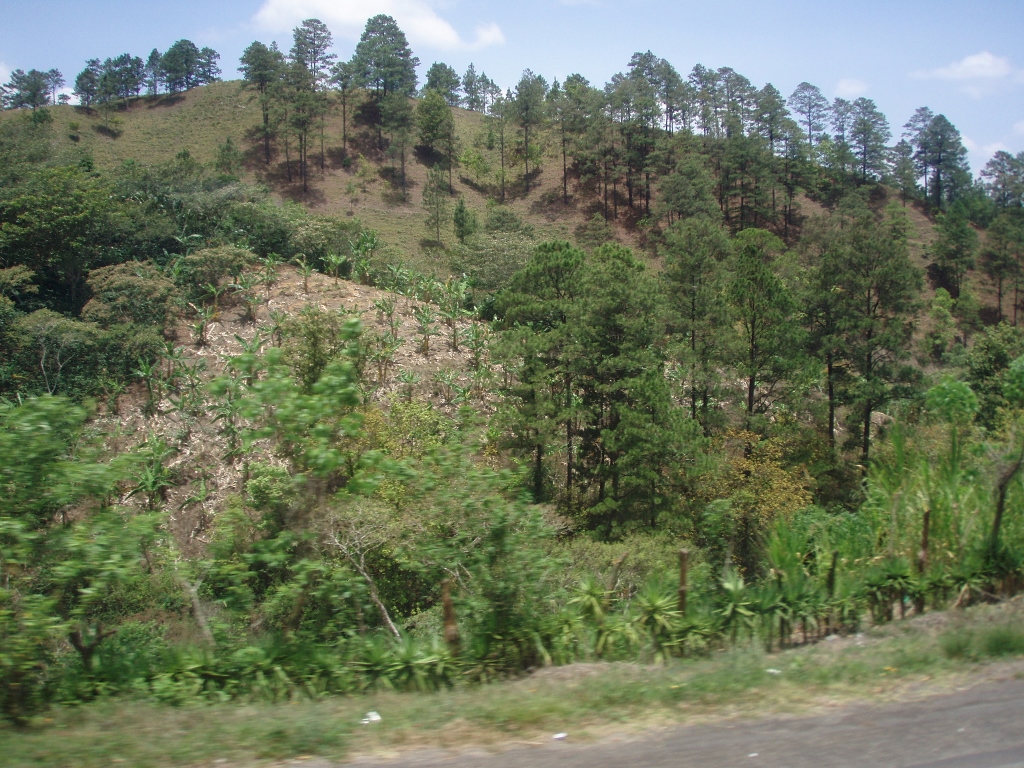 Honduras landscape
Honduras landscape
As smaller banana plantations can be seen in the photo above, perhaps I could mention that bananas are among the most important export commodities in Honduras. By the way, Honduras is the second largest country in Central America (after Nicaragua) and it is also the second poorest (again after Nicaragua). The term used for a small, undeveloped and poor country the whole economy of which depends on the export of one commodity controlled by foreign capital, the banana republic, comes precisely from Honduras that was practically the original “banana republic.”
Namely, at the end of the 19th century, there was an increased demand for bananas in the USA (they are nourishing, exotic and they were also significantly cheaper than local apples) and the fertile landscapes close to the Caribbean coast of Honduras were ideal and very close to the southern states of the USA. Thus, thanks to the connections with the authorities of Honduras, a few American companies started to buy land and produce bananas. By 1918, 75% of the land on which bananas were grown was owned by a couple of American companies, while in 1913 66% of the Honduras exports were bananas. Needless to say, such a powerful position of these large companies had a significant influence on the politics and the economy of the whole country.
I arrived in Tegucigalpa early in the afternoon and so with my big backpack on I walked to a hotel at which I wanted to stay. Here, too, I opted for a place that was close to the terminal in order to facilitate the continuation of my journey, although I knew it would not be at the crack of dawn. In the direct proximity of the hotel there was a market, so along the way I bought a couple of mangoes which I ate in phases during the day.
All in all, upon the arrival, I left my things in the room, freshened up a little, had a short rest and then went for a walk around Tegucigalpa. Although I had good experience in all previous places, just like the rest of the capitals around Central America, this one also did not make a great impression on me at first sight. All the time I had this notion flying through my head that this was not the place in which I would like to live. On the other hand, I’m sure that my impressions would be different, if I had an opportunity to stay actually in them for a longer period of time and to get to know them better.
The capital of Honduras practically consists of two parts – the “real Tegucigalpa” and the neighbouring Comayagüela. However, as these two cities are separated by a smallish river, the Choluteca, it all seems like one big city and they jointly constitute the capital of Honduras. Moreover, I was practically staying in Comayagüela, but this afternoon I walked over to Tegucigalpa.
To start with, I climbed a hillock where there is La Leona Park. This park was only a couple of kilometres away from my hotel and the hillock was certainly not very high, but I still found it strenuous to get up there. That’s why I enjoyed even more the breeze that was blowing there and this all constituted an advantage in comparison to the heat and humidity I was exposed to while in Managua.
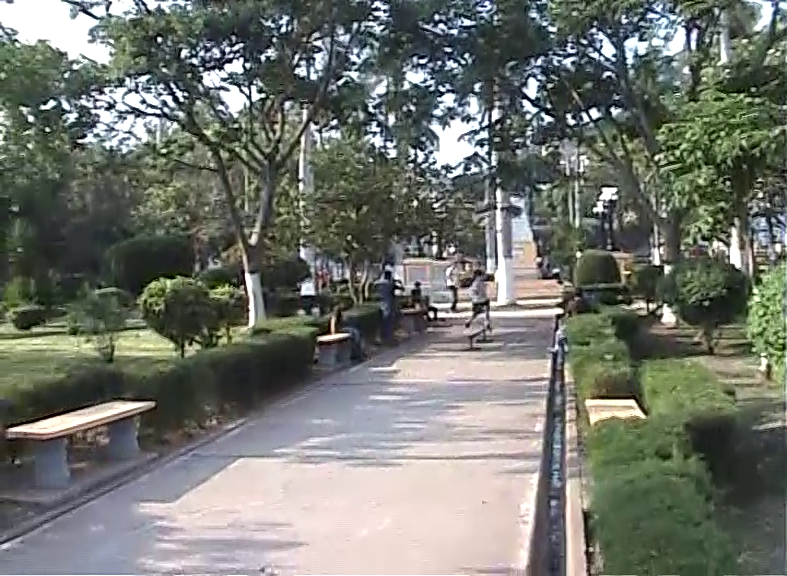 La Leona Park
La Leona Park
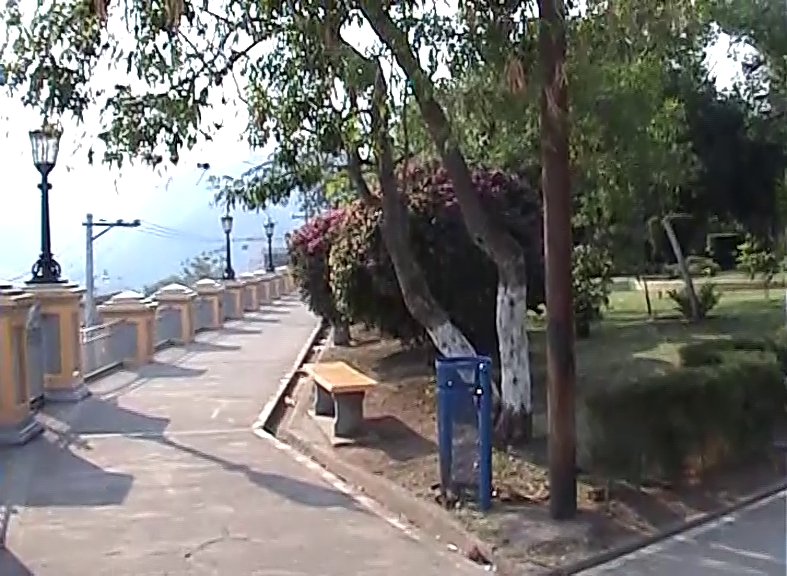 La Leona Park – a path that also serves as a terrace-viewpoint
La Leona Park – a path that also serves as a terrace-viewpoint
From the terrace-viewpoint that exists along the perimeter of the park, there is a fine view at the centre of the city.
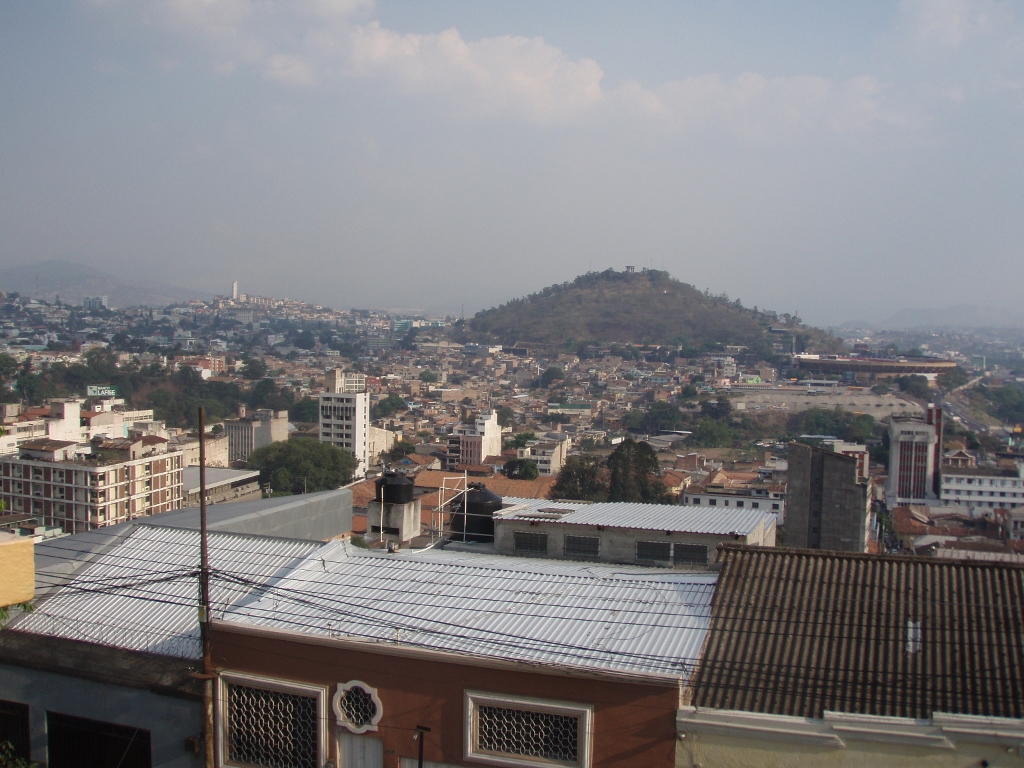 View at Tegucigalpa from the terrace within La Leona Park
View at Tegucigalpa from the terrace within La Leona Park
If you look more closely at the photo above, in addition to the hill called Cerro Juana Lainez on top of which there is the Monument to the Peace, at the foot of the hill, on the right-hand side, it is also possible to see the top of the national football stadium.
I had no intention of going there, but rather descended to the main square called Plaza Morazán, as well as the Parque Central, and there I first looked at the Cathedral.
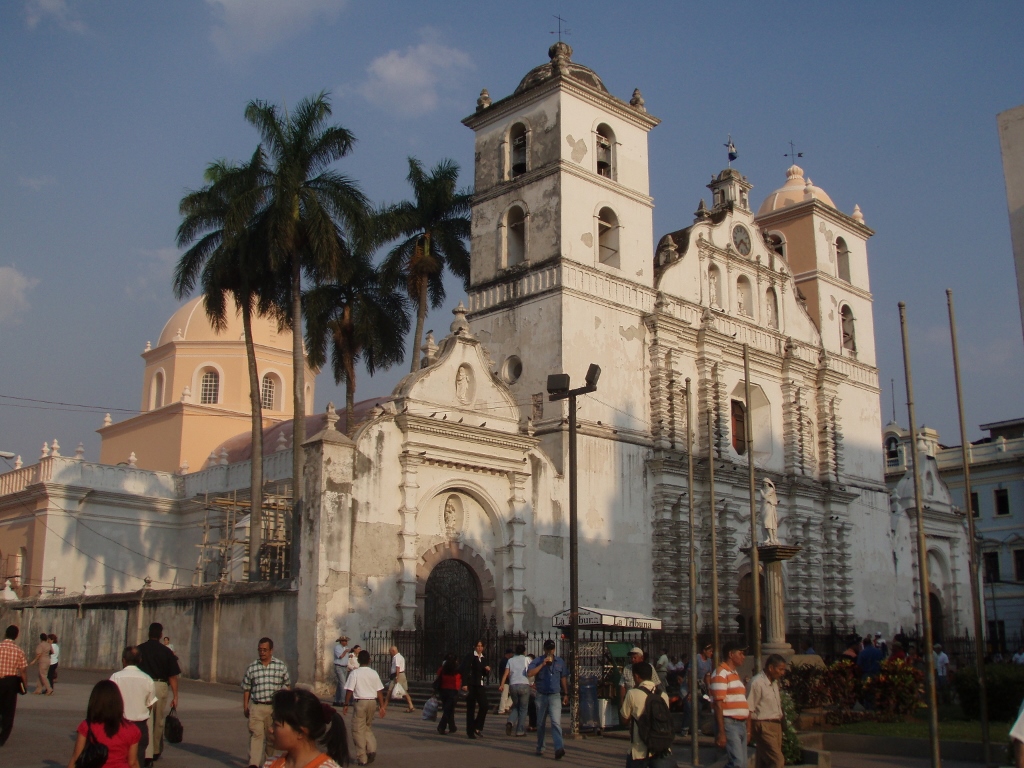 Cathedral in Tegucigalpa
Cathedral in Tegucigalpa
The Cathedral in Tegucigalpa is formally called St. Michael the Archangel Cathedral (Catedral Metropolitana de San Míguel Arcángel) and it was built in the period from 1765 to 1786. Among other things, it is famous for its 18th century altar made of gold and silver.
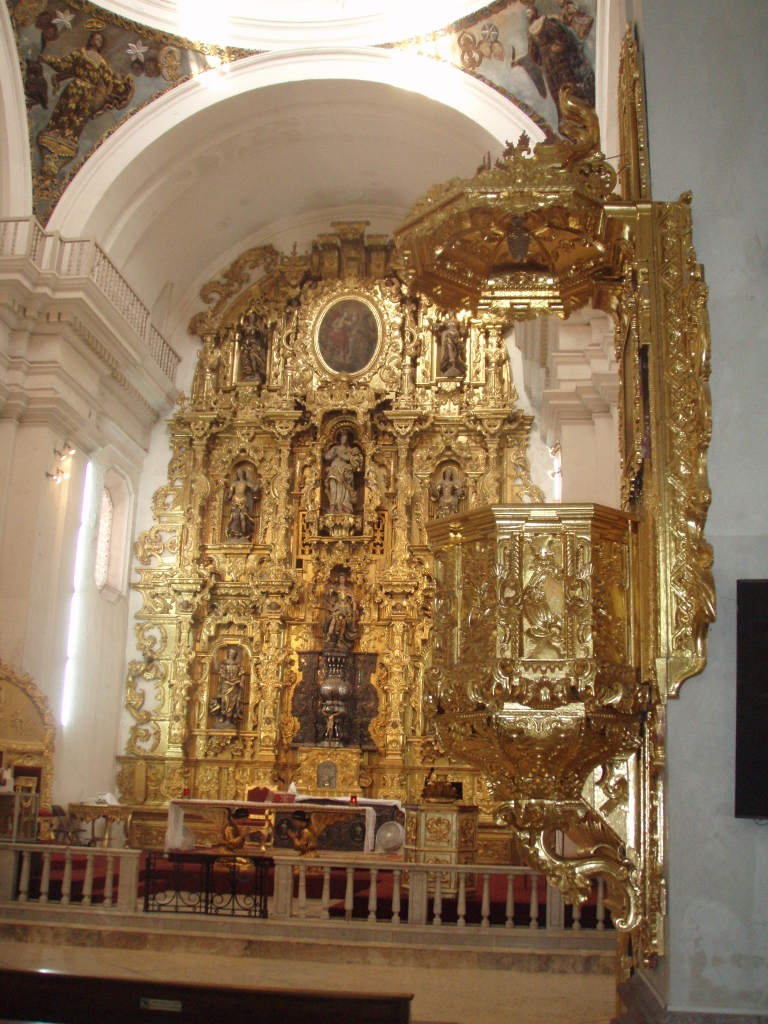 Altar of the Cathedral in Tegucigalpa
Altar of the Cathedral in Tegucigalpa
When you leave the cathedral, you find yourself right away in the square, i.e., in the Central Park and this afternoon there were a lot of people there.
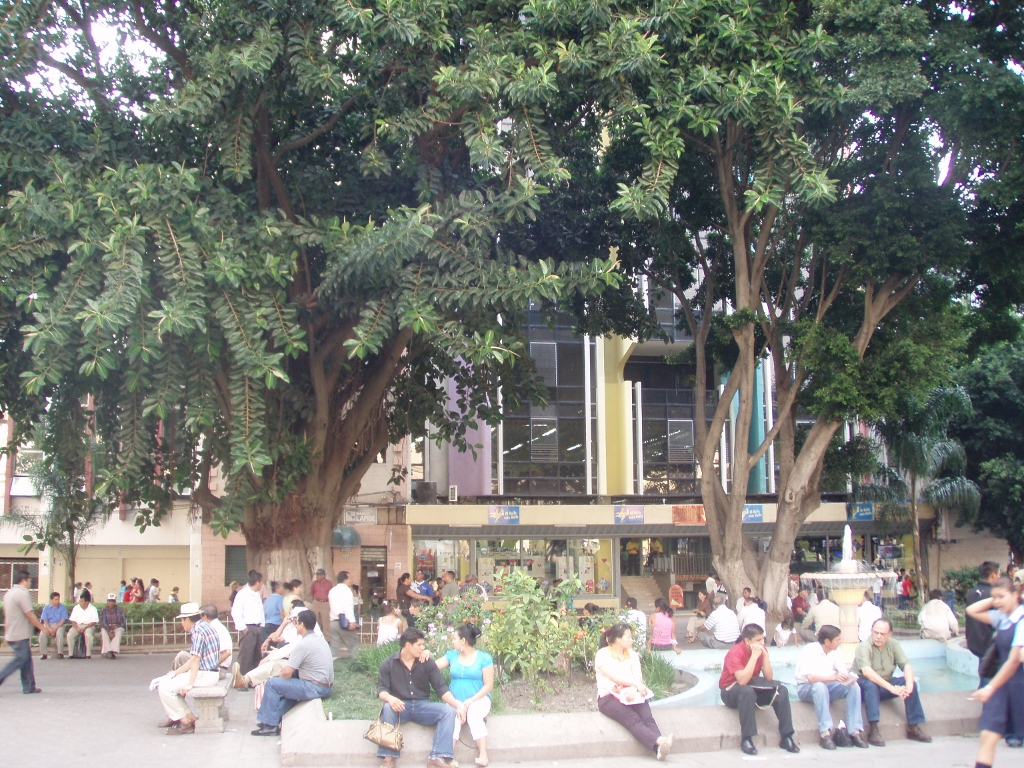 Central Park in Tegucigalpa
Central Park in Tegucigalpa
As I’ve said, the square is also called Morazán after a Central American politician who was born precisely in Tegucigalpa in 1792. In 1821, Central America declared independence from Spain, but then for a short while they were a part of the Empire of Mexico and then in the period from 1823 to 1841 there was also the Federal Republic of Central America. It was in fact Morazán who was in two terms the president of Central America (1830-1939), while being the head of the state of Honduras before that (1827-1830). Like in all historic and political stories from Central America, here, too, there were plenty of turbulent events and so Morazán was executed by a firing squad in 1842. Over time, Francisco Morazán became a martyr and a symbol of the Republic of Central America fighting to preserve the union, while nowadays Central America is full of small countries in which there is still large predominance of corruption, poverty, crime, as well as never-ending fighting over power and influence.
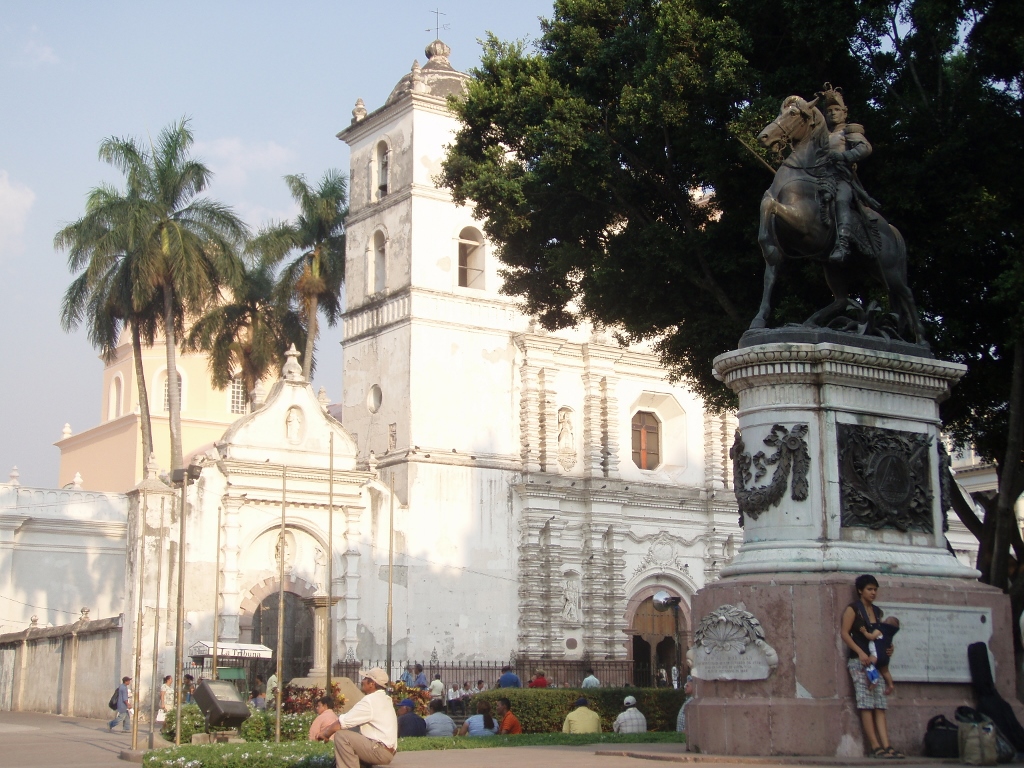 Equestrian statue of Morazán in front of the Cathedral in Tegucigalpa
Equestrian statue of Morazán in front of the Cathedral in Tegucigalpa
There is a pedestrian street starting from here and so I just turned around and quickly took a photo of it.
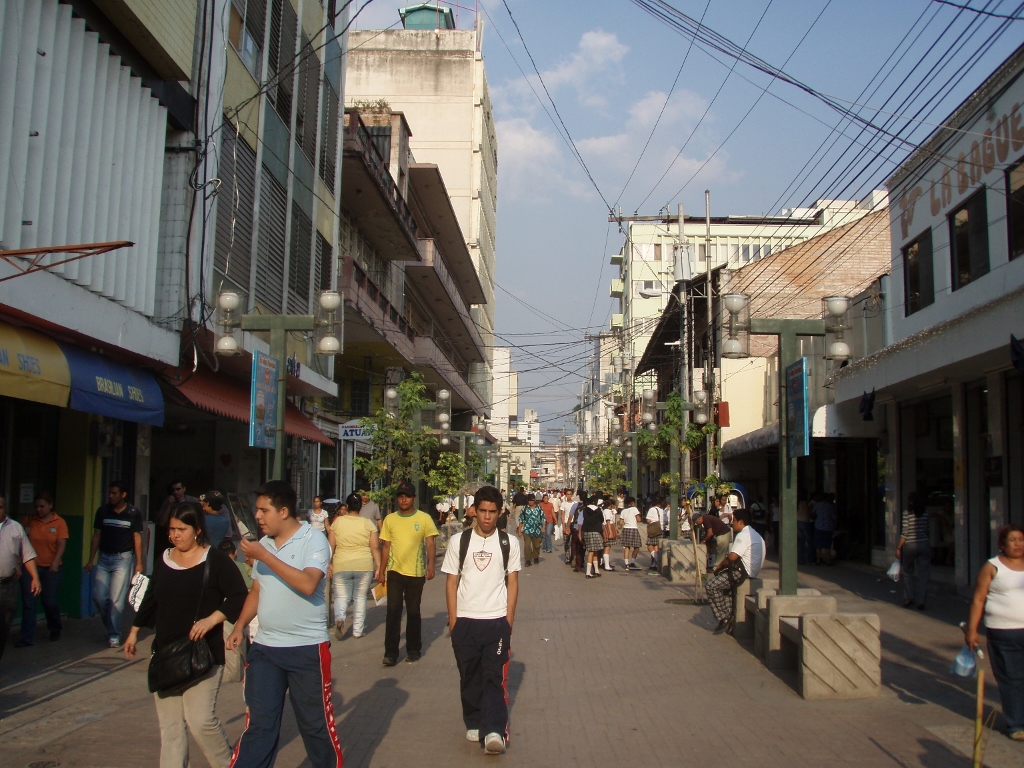 Pedestrian street in Tegucigalpa
Pedestrian street in Tegucigalpa
Namely, I refrained a great deal from taking photos and filming with video-camera since in a lot of places I read that, just like Managua, Tegucigalpa is also a very dangerous city. Moreover, of all the countries in Central America, the homicide rate is highest in Honduras and in two particular places at that: in San Pedro Sula and in Tegucigalpa. Obviously, I didn’t think anybody was out there to kill me, but I was alone and I simply did not want to hold a camera in my hand all the time.
There was one partial personal problem and that was that I was hungry, but I did not have any local money. The banks were already closed and I didn’t see an exchange office anywhere, although there were people in the square that were offering to exchange my money. I am a woman who lived in Serbia during one of the worst hyperinflations in the world ever and also during the later years when the banking and exchange systems did not function normally and so we all used to exchange money on the streets, but this was in my country where I knew the rules and I had no problems with that then. However, in a foreign country, where I knew nothing about it in a practical sense, this was out of question.
I tried to locate a restaurant that I read about in the guidebook, thinking that I would be able to use my credit card there, but I failed to find it. The problem which I personally have with using ATMs on my travels is that once my card got stuck in an ATM and then there was a horrible moment of panic, but in the end it all worked out fine. However, since then I don’t like to use ATMs that are not within a bank that is still open and when I don’t have what I consider to be sufficient time. So, unfortunately, this late afternoon I had to go to a restaurant that belonged to a large international fast-food chain, but I simply had no choice.